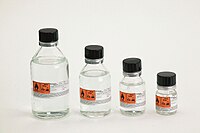
Photo from wikipedia
Zirconium complexes (L2Zr, L = –OC6H2-4-R1-6-R2-2-CH2-N[(CH2)3-N(CH2CH2)2O]-CH2-4-R1-6-R2-C6H2O–, R1 = Me, R2 = tBu, complex 1; R1 = R2 = tBu, complex 2) containing two symmetrical amino-bis(phenolate) ligands were prepared. Moreover, titanium… Click to show full abstract
Zirconium complexes (L2Zr, L = –OC6H2-4-R1-6-R2-2-CH2-N[(CH2)3-N(CH2CH2)2O]-CH2-4-R1-6-R2-C6H2O–, R1 = Me, R2 = tBu, complex 1; R1 = R2 = tBu, complex 2) containing two symmetrical amino-bis(phenolate) ligands were prepared. Moreover, titanium complexes (LTi(OiPr)2, L = –OC6H2-4-R1-6-R2-2-CH2-N[(CH2)3-N(CH2CH2)2O]-CH2-4-R1-6-R2-C6H2O–, R1 = Me, R2 = tBu, complex 3; R1 = R2 = tBu, complex 4) based on symmetrical amino-bis(phenolate) ligands were synthesized. These complexes were characterized by 1H and 13C NMR spectroscopy and elemental analyses. The solid-state structures of complexes 2 and 3 were determined by X-ray diffraction. Complexes 1, 2, 3, and 4 were highly active initiators for the ring-opening polymerization of L-lactide (L-LA) and rac-lactide (rac-LA). The experimental results show that complexes 1 and 2 are highly active and excellent catalysts for the immortal ring-opening polymerization (iROP) of L-lactide and rac-lactide in the melt state. The monomer-to-complex ratio reached 200 000/1, which is the highest feeding molar ratio of lactide so far, to the best of our knowledge. Meanwhile, a narrow polydispersity index (1.11–1.58) of polymers was obtained, and the number-average molecular weight approached 8.64 × 104 g mol−1. The turnover frequency (TOF) reached 6593 h−1, and the polymerization proceeded smoothly even in an air environment.
Journal Title: New Journal of Chemistry
Year Published: 2017
Link to full text (if available)
Share on Social Media: Sign Up to like & get
recommendations!